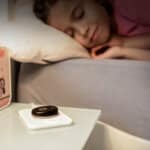Music Activities for Children With Hearing Implants: Build a Tambourine

Music isn’t just fun. It’s also a great way to help your child learn and develop communication, listening, language, cognitive, fine and gross motor, social, and emotional skills. And research also shows that children who use hearing technology can benefit from all of this, too. With that in mind, today’s blog article shares a two-part musical activity about percussion instruments.
Part 1: Introducing Percussion Instruments
This activity provides opportunities for children to focus on listening to the different sounds and to learn new vocabulary and concepts. Here’s how to do it:
- Introduce your child to a variety of percussion instruments, one at a time. These could include a drum, shaker, bells, a tambourine, and a xylophone. Homemade instruments such as pots and pans with a wooden spoon, and shakers made from dry rice in a bottle, work just as well.
- Find two instruments that have a large sound difference. Introduce each instrument to your child, name and describe each, and spend time playing them, so your child can hear and focus on the sounds the different instruments make.
- While playing the instruments, teach your child music-related vocabulary such as:
- Names of instruments: drum, cymbals, tambourine, triangle
- Descriptions of the instruments: big, little, round, long, hard, soft, shiny
- Actions: bang, tap, hit, shake, strike, play
- Sound: loud, soft, boom, chime
- Follow your child’s lead. Talk about what they are looking at and interested in. Imitate the patterns they are playing on the instrument, and add movement and singing.
Part 2: Make Your Own Tambourine
Extend this activity by making an instrument with your child. This enjoyable activity provides many opportunities to introduce and help develop your child’s vocabulary, sentence production, and articulation.
What You’ll Need
- Paper or plastic plate
- A hole punch
- Small bells
- String
Instructions
- Punch holes around the outer edge of the plate (one for each bell). Attach the bells to the plate with string.
- Teach your child action words while you make the tambourine by using the keywords with repetition and acoustic highlighting. Teach push, tie, cut, and make.
- Have your child decorate their tambourine by coloring it, drawing pictures, or adding stickers.
- Use words to describe what your child is doing and how the tambourine looks e.g., paste, stick, color, draw, shiny, round.
Once it’s ready, you can talk about how the tambourine sounds e.g., I can hear the bells ringing, it’s noisy. Encourage your child to show others their new tambourine to practice their talking. You may need to model sentences for them e.g., “Tell grandma, my tambourine is shiny”. You can also extend the sentences your child says e.g., if they say, “me shake”, you can model “Yes, you can shake it”.
This activity is part of Musical EARS®. Designed for caregivers as well as professionals, it has concrete music activities that can be used in therapy, at school, or at home. The activities can be used to enhance music perception and appreciation in children with hearing implants, as well as support communication development.
If you would like to see more of Musical EARS®, the resource is free to download from the MED-EL Academy.
Thanks for your message. We will reply as soon as possible.
Send us a message
Field is required
John Doe
Field is required
name@mail.com
Field is required
What do you think?
The content on this website is for general informational purposes only and should not be taken as medical advice. Please contact your doctor or hearing specialist to learn what type of hearing solution is suitable for your specific needs. Not all products, features, or indications shown are approved in all countries.


